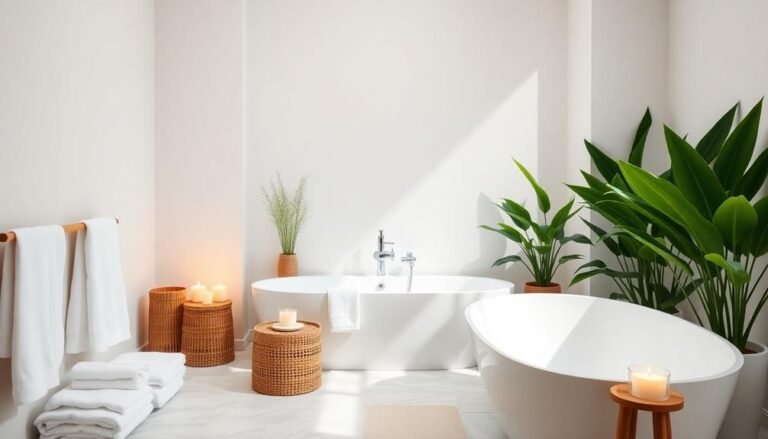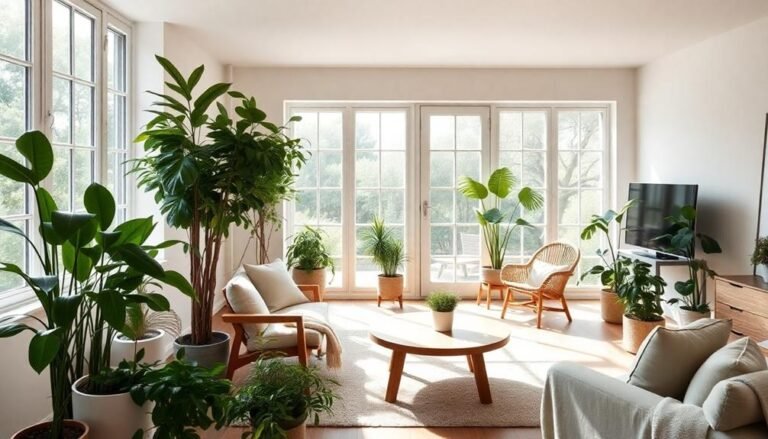To effectively use sound in your home decor, start by evaluating the sound elements in your space. Incorporate soundproofing techniques, like sealing gaps around doors and using heavy drapes to absorb noise. Consider adding water features, such as indoor fountains, which not only promote relaxation but also mask disruptive sounds. Utilize soft furnishings like rugs and curtains to dampen sound while enhancing your room's aesthetic. Create a calming ambiance with soft music or nature sounds. Balancing sound and visual elements will elevate your decor, making your space both inviting and harmonious. There's plenty more to discover as you explore this topic further.
Understanding Sound in Decor
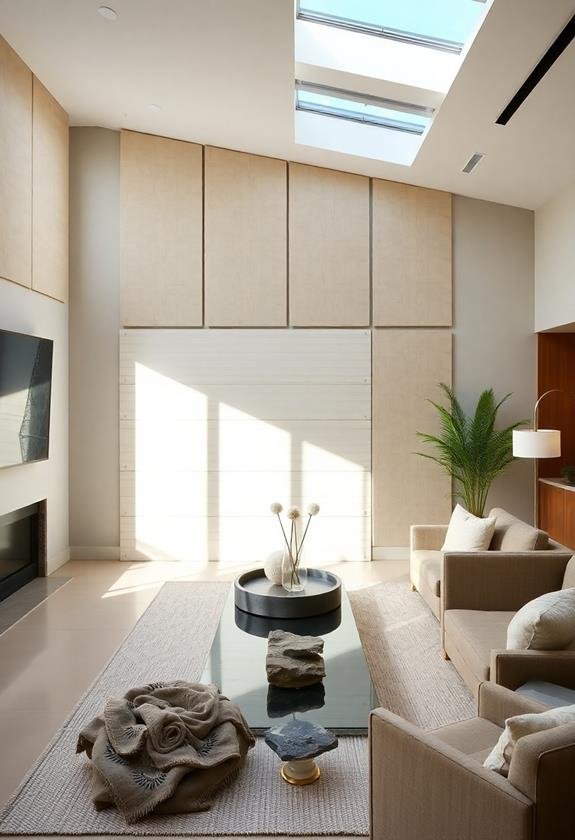
In the domain of home decor, sound often takes a backseat to visual aesthetics, but understanding its role can transform your space. Sound isn't just an afterthought; it shapes your environment and influences your mood. Imagine stepping into a room that's filled with the soft, soothing sound of water trickling from a fountain. Instantly, you feel relaxed, and that ambiance enhances your overall experience. Incorporating elements like sound machines can further enhance this serene atmosphere, providing a consistent backdrop of calming sounds.
Consider how sound interacts with design elements. Hard surfaces like tile and glass reflect noise, creating echo and a sense of chaos, while soft furnishings—like carpets and curtains—absorb sound, resulting in a cozier atmosphere. If you've ever been in a bustling café, you've likely noticed how the blend of voices and clinking dishes creates a lively energy. This same principle applies to your home; you can curate a soundscape that reflects your personality and promotes your desired mood.
Incorporating thoughtful sound elements can elevate a room. Whether it's adding a gentle playlist, using sound-absorbing materials, or including natural elements like wind chimes, you have the power to create an inviting and harmonious environment that resonates with you and your guests. Understanding sound in decor is a key step to achieving that.
Effective Soundproofing Techniques
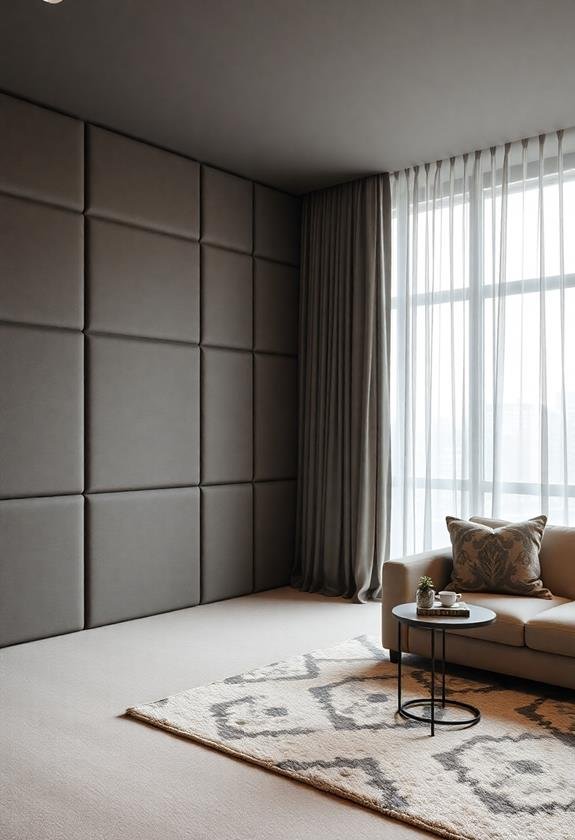
Sound can greatly impact your living space, and when it comes to creating a calm environment, effective soundproofing techniques become essential. Start by identifying the sources of noise that disrupt your comfort, whether it's traffic, noisy neighbors, or appliances. Once you pinpoint the problem areas, consider sealing gaps around doors and windows with weather stripping or door sweeps. This simple step can considerably reduce unwanted sound infiltration.
Next, think about your walls. Adding heavy drapes or acoustic panels can absorb sound, making a noticeable difference. If you're up for a more involved project, consider installing drywall with soundproofing materials that enhance insulation. Rugs and carpets can also help; they not only add warmth but also dampen sound, particularly in larger rooms.
Additionally, you might want to rearrange your furniture. Placing bookshelves or large pieces against shared walls can act as barriers, effectively blocking noise. Remember, effective soundproofing doesn't have to be expensive. Simple changes and thoughtful arrangements can transform your space into a placid retreat, allowing you to enjoy the serenity you deserve.
Choosing the Right Materials
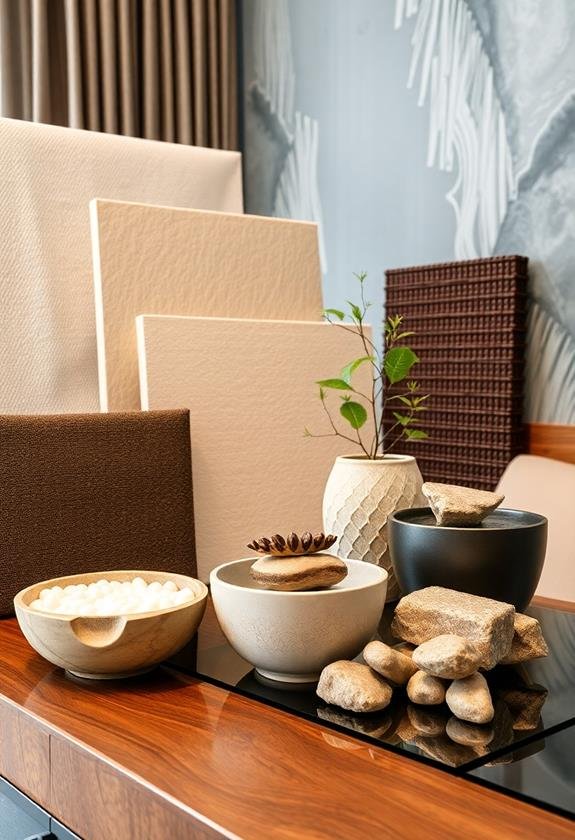
Selecting the right materials is essential for achieving effective soundproofing in your home. You'll want to contemplate options that absorb sound rather than reflect it. For instance, dense materials like mass-loaded vinyl, acoustic panels, and heavy drapes can greatly reduce noise transmission. In fact, using heavyweight curtains can enhance noise reduction while also providing thermal insulation. When it comes to flooring, carpets and rugs not only add warmth but also help to dampen sound.
In addition, think about your walls; drywall with soundproofing properties or adding an extra layer can greatly enhance your sound insulation. If you're looking for something more permanent, you might reflect on soundproofing insulation, which fits between the studs in your walls.
Windows are another critical area; double-glazed windows effectively block outside noise. While choosing materials, don't forget about the doors; solid-core doors can be a game-changer in minimizing sound leakage.
Incorporating Water Features

The peaceful ambiance created by water features can transform your home into a serene retreat. Whether you opt for a small tabletop fountain or a larger outdoor pond, the sound of flowing water can soothe your senses and enhance your living space. Consider placing a fountain in your entryway; the gentle trickle welcomes guests with a calming effect. Alternatively, a wall-mounted water feature in your living room can serve as a stunning focal point while providing a placid backdrop to your daily activities.
When incorporating water features, think about the size and style that best fits your home. A sleek, modern design might complement your minimalist decor, while a rustic stone fountain could enhance a cozy, traditional space. Also, consider the maintenance involved; some features require regular cleaning and water replacement, while others are more self-sustaining.
Don't forget about the lighting! Illuminating your water feature can create enchanting reflections and shadows, adding to the overall ambiance. By thoughtfully incorporating these elements, you'll not only enhance your home's aesthetic but also create a peaceful atmosphere that encourages relaxation and rejuvenation.
Utilizing Sound-Absorbing Decor

Creating a harmonious living environment involves not just inviting soothing sounds, like those from water features, but also managing unwanted noise. One effective way to achieve this is by utilizing sound-absorbing decor. Soft furnishings, such as plush rugs, thick curtains, and upholstered furniture, can considerably dampen sound waves, creating a more serene atmosphere in your home. Additionally, incorporating decorative storage solutions, like durable cotton rope baskets, can help organize your space while also absorbing sound, further enhancing calmness.
Consider adding acoustic panels or wall art made from sound-absorbing materials. These can enhance your décor while effectively reducing echoes, especially in larger spaces. You might also explore decorative items like fabric wall hangings or quilts that not only add visual interest but also serve a functional purpose in sound absorption.
Additionally, houseplants can play a role in minimizing noise. Their leaves and stems can diffuse sound, making your environment feel cozier and quieter. If you're looking for a stylish solution, think about incorporating bookshelves filled with books or knick-knacks; they can act as barriers to sound, creating a buffer against external disturbances. By thoughtfully selecting sound-absorbing decor, you can transform your space into a serene retreat, where the noise of the outside world fades away, allowing for relaxation and comfort.
Creating a Relaxing Ambiance
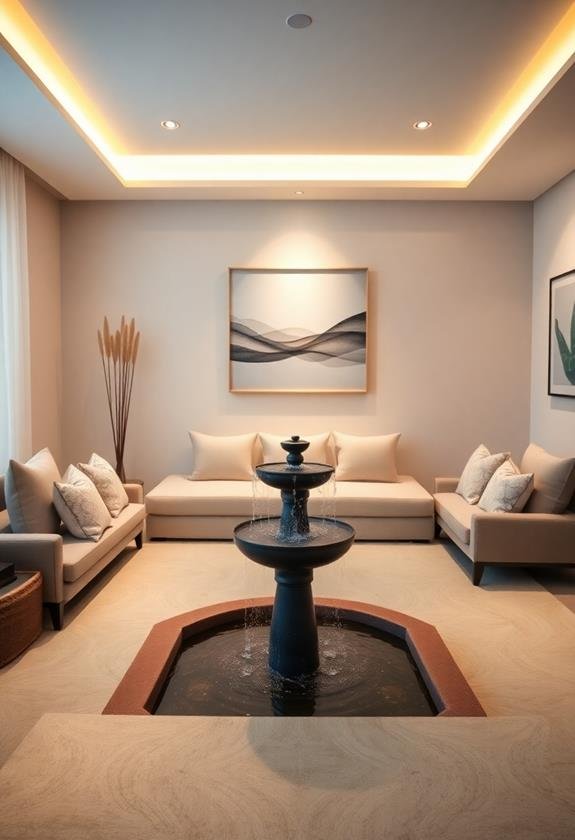
How can you transform your home into a sanctuary of relaxation? Creating a calming atmosphere involves incorporating sound elements that soothe the mind and body. Start by evaluating the sounds in your space; silence can be just as powerful as gentle music or nature sounds. You want to eliminate harsh noises and introduce softer, more harmonious sounds that promote serenity.
Consider these key elements to enhance your home's ambiance:
- Soft music: Play instrumental or nature-inspired tracks to create a peaceful background.
- Water features: Incorporate a small fountain or aquarium, as the sound of flowing water can be incredibly calming.
- Natural sounds: Use sound machines or apps that replicate rain, ocean waves, or bird songs to bring the outdoors inside.
Balancing Sound and Aesthetics
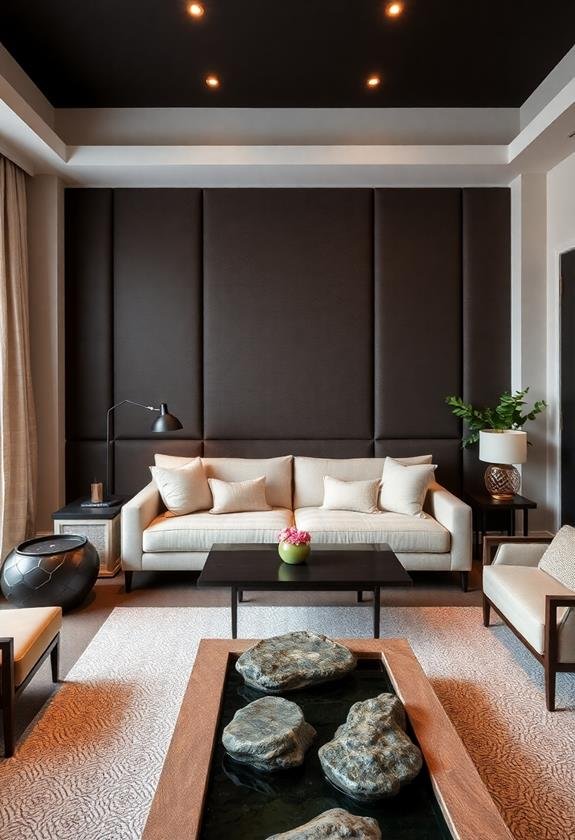
Achieving harmony between sound and aesthetics can elevate your home decor to a new level of comfort and style. You don't have to sacrifice beauty for functionality; instead, consider how sound elements can enhance your space. For instance, incorporating soft furnishings like plush rugs, curtains, and cushions not only adds visual appeal but also absorbs sound, creating a cozy atmosphere.
Think about using water features, such as indoor fountains, which provide a soothing auditory backdrop while serving as stunning focal points. They can mask unwanted noise and evoke a serene vibe in any room.
On the other hand, be mindful of materials that might amplify sound, like hardwood floors or tile surfaces. Balancing these elements is key—add area rugs or upholstered furniture to mitigate noise while maintaining your desired aesthetic.
Lastly, consider your lighting. Soft, warm lighting can complement soundscapes and enhance the overall ambiance, making your space feel inviting and harmonious. By thoughtfully integrating sound with your design choices, you'll create an environment that not only looks great but feels great, too.
Frequently Asked Questions
Can Soundproofing Increase the Value of My Home?
Yes, soundproofing can increase your home's value. By minimizing noise, you create a more peaceful living environment, which many buyers find appealing. Imagine walking into a home where outside distractions are virtually eliminated; it instantly feels more inviting. Quality soundproofing materials can enhance your home's overall comfort and appeal, making it a worthwhile investment. Plus, as urban living becomes more common, noise reduction features can set your property apart in the competitive real estate market.
What Are the Most Affordable Sound-Absorbing Materials Available?
When looking for affordable sound-absorbing materials, you might consider options like acoustic foam panels, carpets, or heavy curtains. These materials effectively dampen sound and reduce echoes in your space. For instance, placing rugs in high-traffic areas can absorb noise, while installing foam panels on walls can enhance a room's acoustics. Even simple DIY solutions, like using egg cartons for temporary soundproofing, can make a difference without breaking the bank.
How Can I Test My Space's Sound Levels Effectively?
To test your space's sound levels effectively, start by using a sound level meter, which measures decibels. Walk around your space, noting areas with higher noise levels. You can also record sounds at different times to capture variations, like during peak activity hours. Finally, consider asking friends for feedback on their experience within your space. Their impressions can provide valuable insights into how sound travels and impacts your environment.
Are There Specific Colors That Enhance Sound Absorption?
When it comes to enhancing sound absorption in your space, colors can play a subtle yet impactful role. Darker shades, like deep blues and rich greens, often absorb sound better than lighter colors. Additionally, textured materials, such as fabric wall hangings in those hues, can considerably boost absorption. So, by thoughtfully selecting and combining these colors, you can create an environment that not only looks appealing but also sounds more pleasant and balanced.
Can I Combine Different Water Features for Better Sound Effects?
Yes, you can combine different water features to enhance sound effects in your space. For instance, placing a small fountain next to a pond can create a soothing symphony of water sounds. Experimenting with varying sizes, shapes, and water flows will yield unique auditory experiences. Just be mindful of the overall harmony; too much noise can become overwhelming. By thoughtfully arranging these elements, you'll achieve a peaceful atmosphere that invites relaxation and enjoyment.



